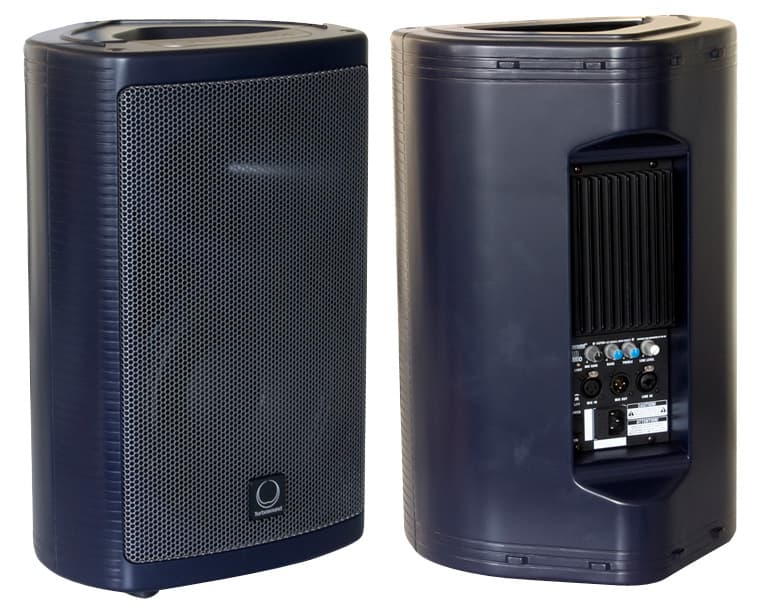
Review: Turbosound Milan MiO
The Milan MiO packs a big impression into a small package.
Following the success of the Milan M15 active speaker Turbosound has released a downsized version called the Milan MiO. The Milan M15 made a big impression on me with its combination of brand credibility, good looks and great sound quality. There are a lot of powered boxes out there but the Milan M15 rose to the top by offering excellent voicing and deep, useable bass from its 60L capacity cabinet. It works well for front-of-house duties at small to medium shows and while its size is needed for the extended bass response, it is a bigger box than some users will be able to deal with. It’s not too heavy but its size means some effort is required to carry it and mount it on a pole, and while it’s designed to be used as a floor monitor as well as front-of-house, it does take up a fair amount of real estate on stage, so it’s best suited to big stages.
Enter the Milan MiO: Same looks, same voicing, but half the size and half the weight. With a 10-inch woofer and one-inch tweeter it’s entered an even more competitive field than the Milan M15. These smaller active speakers are everywhere now and they’re not just for sound people. Musicians often carry them and use them as either monitors or as a PA. Schools and businesses use them for portable sound reinforcement and bars or clubs use them for background music. These applications naturally benefit from high sound quality and convenient size but there’s a greater emphasis on ease of operation. The Milan MiO has been designed with this in mind so the controls and input options are simpler than the Milan M15.
WELL-TUNED VOICE
With a microphone plugged in, the MiO has a similar voicing to the M15. They are both well-tuned for normal mics with Shure SM58/Beta58s sounding just right. The response between 2kHz and 4kHz is quite subdued so mics with presence peaks come out fairly flat and at high volumes feedback and harshness are minimised. This voicing is what gives the Turbosound Milans the edge over competitors. I like the popular, and competing, QSC K-Series speakers but in a side-by-side comparison the MiO is noticeably smoother in the HF driver and more solid overall, although the QSC is slightly louder. The MiO has a fast acting onboard limiter that effectively prevents the speaker from being overdriven. Sound quality is maintained at all levels and even if full level is not hugely loud it’s better to stay clean than allow the system to distort, especially if it’s being operated by non-professional users.
The gain structure follows this theme of easy and overload-free operation. The mic gain has been calibrated so it can be turned up full and that gives you about the right level if you’re using the MiO as a floor wedge. With an SM58 and the mic gain up full it’s just under the threshold of feedback. It makes the mic input fairly foolproof for amateur users but I found it somewhat disconcerting to need full gain to get a good level…it’s a bit like a car that’s limited to 100kmh. It won’t exceed the speed limit but what if you need to? It’s OK if you’re up on the mic and putting a bit into it but if you were using a mic with a low output level or, more likely, dealing with soft source levels I worry that you might not be able to get enough gain.
NEED TO KNOW

LEANING ON IT
Used as foldback wedges the MiO angles up at the regulation 43 degrees. They look compact and professional on stage, whereas the Milan15s can look too big. There was a time in rock when big wedges seemed necessary but I’ve never liked the way they block the audience’s view of the performers’ lower legs, it makes the performers look shorter, and some have attractive ankles that should be seen. The MiOs are loud enough for all but full rock level and if fidelity is more important than absolute volume then the MiOs are a pleasure to use on stage.
For music playback the MiO’s voicing and smooth sound make for very enjoyable listening at all volumes up to its maximum. Its warmth and lack of hardness in the 2 – 4kHz range make it ideal for low to medium level background music. The frequency response is quoted at 55Hz – 20kHz (±3dB) and there’s enough useable low end for most situations. For low level playback some added low EQ fills the bottom out nicely. Dispersion is quite wide at 90 x 60 degrees and the sound is even right across the front of the speaker without beaminess directly on axis. As is common with active speakers the idling noise is noticeable in a quiet setting but you’re unlikely to hear it in a live setting.
Placement/mounting options abound and have been well thought through. On the bottom of the cabinet there are three good-sized hard rubber feet. Two pole-mount holes provide for either vertical or angled-down mounting. For floor wedge use they can be used on either side so the horn can be on the right or left as desired. Six M10 rigging points make it possible to fly the speakers upright, upside down, angled or sideways and an optional wall-mount bracket is available. Specially designed padded slip-on covers are available for safely transporting the speakers and sudden rain events. Replacement drivers and amplifiers are available as spare parts and I know from personal experience that Turbosound’s after sales service is excellent.

















RESPONSES